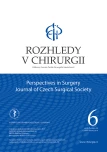-
Medical journals
- Career
Combined endovascular and surgical treatment of symptomatic tandem occlusion of common carotid artery and middle cerebral artery – case repor
Authors: A. Hudák 1; I. Guňka 1; Miroslav Lojík 2; M. Leško jr. 1; S. Jiška 1; F. Caisberger 3; D. Krajíčková 3
Authors‘ workplace: Chirurgická klinika Lékařské fakulty Univerzity Karlovy a Fakultní nemocnice Hradec Králové 1; Radiologická klinika Lékařské fakulty Univerzity Karlovy a Fakultní nemocnice Hradec Králové 2; Neurologická klinika Lékařské fakulty Univerzity Karlovy a Fakultní nemocnice Hradec Králové 3
Published in: Rozhl. Chir., 2019, roč. 98, č. 6, s. 252-255.
Category: Case Report
Overview
Introduction: Cerebrovascular events are among the most common causes of invalidity or death. The aim of treatment in acute cerebral ischemia is to restore the blood flow before irreversible necrosis of brain tissue and persistent neurologic deficit occur. Pharmacological, endovascular and surgical methods are employed in the treatment of these patients.
Case report: The authors present a case report of a 56-year-old woman with acute cerebral ischemia caused by tandem occlusion of the left common carotid artery and the M1 segment of middle cerebral artery. In the initial phase the patient was treated by intravenous thrombolysis with minimal success. Common carotid artery was occluded and mechanical extraction of embolus was successfully performed through direct carotid bifurcation puncture. Almost complete regression of neurologic deficit occurred after the endovascular recanalization. Occluded common carotid stump and bifurcation was considered as a source of embolization and therefore, to prevent further cerebrovascular event, a subclavian-carotid bypass was performed on the 15th day after the stroke.
Conclusion: In the reported patient with symptomatic tandem occlusion of common carotid artery and the M1 part of middle cerebral artery, recanalization of cerebral artery was attained by the combination of pharmacological and endovascular method. Consequent subclavian-to-carotid bypass was performed in tertiary prevention of further cerebrovascular event.
Keywords:
stroke – tandem lesion – common carotid artery occlusion – subclavian-to-carotid bypass – direct carotid puncture
Sources
-
Writing G, Naylor AR, Ricco JB − editor‘s. Choice – management of atherosclerotic carotid and vertebral artery disease: 2017 Clinical Practice Guidelines of the European Society for Vascular Surgery (ESVS). Eur J Vasc Endovasc Surg 2018;55 : 3−81.
-
Bajko Z, Balasa R, Motataianu A, et al. Common carotid artery occlusion: a case series. ISRN Neurol. 2013 : 198595. doi: 10.1155/2013/198595.
-
Klonaris C, Kouvelos GN, Kafeza M, et al. Common carotid artery occlusion treatment: revealing a gap in the current guidelines. Eur J Vasc Endovasc Surg. 2013;46 : 291−8. doi: 10.1016/j.ejvs.2013.06.006.
-
Lai SL, Chen YC, Weng HH, et al. Bilateral common carotid artery occlusion--a case report and literature review. J Neurol Sci. 2005;238 : 101−4. doi: 10.1016/j.jns.2005.06.012.
-
Sharma VK, Tsivgoulis G, Lao AY, et al. Thrombotic occlusion of the common carotid artery (CCA) in acute ischemic stroke treated with intravenous tissue plasminogen activator (TPA). Eur J Neurol. 2007;14 : 237−40. doi: 10.1111/j.1468-1331.2006.01654.x
-
Shah QA. Spontaneous recanalization after complete occlusion of the common carotid artery with subsequent embolic ischemic stroke. J Vasc Interv Neurol. 2009;2 : 147−51.
-
Riles TS, Imparato AM, Posner MP, et al. Common carotid occlusion. Assessment of the distal vessels. Ann Surg. 1984;199 : 363−6.
-
Pintér L, Cagiannos C, Bakoyiannis CN, et al. Hybrid treatment of common carotid artery occlusion with ring-stripper endarterectomy plus stenting. J Vasc Surg. 2007;46 : 135−9. doi: 10.1016/j.jvs.2007.01.062
-
Ziomek S, Quinones-Baldrich WJ, Busuttil RW, et al. The superiority of synthetic arterial grafts over autologous veins in carotid-subclavian bypass. J Vasc Surg. 1986;3 : 140−5.
-
Fry WR, Martin JD, Clagett GP, et al. Extrathoracic carotid reconstruction: the subclavian-carotid artery bypass. J Vasc Surg. 1992;15 : 83−8; discussion 8−9.
-
Belkin M, Mackey WC, Pessin MS, et al. Common carotid artery occlusion with patent internal and external carotid arteries: diagnosis and surgical management. J Vasc Surg. 1993;17 : 1019−27; discussion 27−8.
-
Brott TG, Halperin JL, Abbara S, et al. ASA/ACCF/AHA/AANN/AANS/ACR/ASNR/CNS/SAIP/SCAI/SIR/SNIS/SVM/SVS guideline on the management of patients with extracranial carotid and vertebral artery disease: a report of the American College of Cardiology Foundation/American Heart Association Task Force on Practice Guidelines, and the American Stroke Association, American Association of Neuroscience Nurses, American Association of Neurological Surgeons, American College of Radiology, American Society of Neuroradiology, Congress of Neurological Surgeons, Society of Atherosclerosis Imaging and Prevention, Society for Cardiovascular Angiography and Interventions, Society of Interventional Radiology, Society of NeuroInterventional Surgery, Society for Vascular Medicine, and Society for Vascular Surgery. J Am Coll Cardiol. 2011;57:e16−94.
-
Liapis CD, Bell PR, Mikhailidis D, et al. ESVS guidelines. Invasive treatment for carotid stenosis: indications, techniques. Eur J Vasc Endovasc Surg. 2009;37(4 Suppl):1−19. doi: 10.1016/j.ejvs.2008.11.006.
Labels
Surgery Orthopaedics Trauma surgery
Article was published inPerspectives in Surgery

2019 Issue 6-
All articles in this issue
- Development of vascular substitutes for low-flow peripheral bypass grafting – a review
- Splanchnic vein closures
- Bleeding from lumbar ventral epidural venous plexus managed with hemostatic agent from oxidized non-regenerated cellulose
- Catheter laser ablation of superficial veins of the lower extremities in the symptomatic treatment of venous reflux − comparison of the immediate results of two types of laser
- Iatrogenic thoracic aortic injury in esophagectomy – a case report and literature review
- Mladí, chcete operovat? Přidejte nám na důchody!
- Combined endovascular and surgical treatment of symptomatic tandem occlusion of common carotid artery and middle cerebral artery – case repor
- Madelung’s disease – a case report
- Perspectives in Surgery
- Journal archive
- Current issue
- Online only
- About the journal
Most read in this issue- Madelung’s disease – a case report
- Splanchnic vein closures
- Combined endovascular and surgical treatment of symptomatic tandem occlusion of common carotid artery and middle cerebral artery – case repor
- Development of vascular substitutes for low-flow peripheral bypass grafting – a review
Login#ADS_BOTTOM_SCRIPTS#Forgotten passwordEnter the email address that you registered with. We will send you instructions on how to set a new password.
- Career

